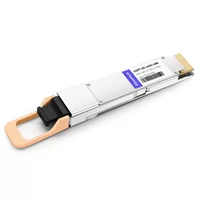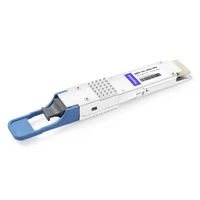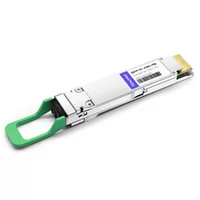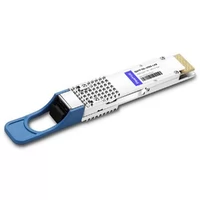Since entering the market in early 2019, 400G switches have gained a lot of recognition from users. According to market research firm Dell’Oro, shipments of 400G switch ports will reach 15 million in 2023. To comply with the market development and meet the high-performance requirements of 400G networks, most suppliers have begun to work on 400G network solutions, including the research and development of 400G optical transceivers and MTP/MPO fiber jumper products. This article will introduce you to 400G network solutions in detail.
400G Optical Transceiver and MTP/MPO Fiber Jumper Overview
As we all know, optical transceivers and fiber patch cords are the most important infrastructure for network connection, and 400G network solutions are no exception. Today, thanks to the development of 400G Ethernet technology, different types of 400G optical transceivers such as 400G SR8/DR4/FR4/FR8/LR8/SR16 emerge in an endless stream. Among them, QSFP-DD, OSFP packaged 400G SR8/DR4/FR4 optical transceivers have frequently appeared at Optical Fiber Communication Exhibitions and Seminars (OFC), and some suppliers have started to sell 400G SR8/DR4/FR4 optical transceivers in QSFP-DD or OSFP form factors.
- The 400G SR8 QSFP-DD/OSFP optical transceiver is defined by the IEEE P802.3cm task force and is designed to achieve short-distance transmission through 16-core MTP/MPO multimode fiber patch cord connections, with a maximum transmission distance of 100 meters;
- The 400G DR4 QSFP-DD/OSFP optical transceiver complies with the IEEE 802.3bs standard and is designed to achieve 500 meters of transmission through 8-core or 12-core MTP/MPO single-mode fiber patch cord connections;
- 400G FR4 QSFP-DD/OSFP optical transceiver meets the requirements of 100G Lambda MSA. Different from the above two types of 400G optical transceivers, this type of optical transceiver only uses 4 lasers and achieves a transmission of 2 kilometers through an LC duplex single-mode fiber jumper connection.
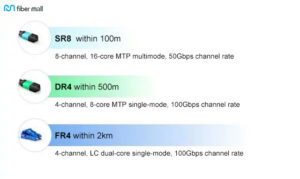
In simple terms, 400G network transmission within 500 meters generally needs to be used with MTP/MPO fiber jumpers, and the specific number of cores depends on the model of the optical transceiver.
Typical 400G Network Solutions
Common 400G network connection methods include 400G-400G, 400G-4x100G, 400G-2x200G, and 400G-5x80G. The following will focus on these four 400G network solutions.
- 400G-400G direct connection
400G direct connection is the simplest connection method, which just needs to select the corresponding fiber jumper to connect the 400G optical transceivers at both ends. Take the 400G SR8 optical transceiver as an example, it uses eight 50Gbps channels. In most cases, a 16-core MTP/MPO multimode fiber jumper is used. The connection method is as follows. It is expected that this 400G network solution will be used by hyperscale cloud service providers in China and North America.

| Number | Product |
|---|---|
| ① | 400G SR8 QSFP-DD |
| ② | 16-core MTP fiber patch cord |
As mentioned above, the 400G-DR4 optical transceiver can be used with both 8-core MTP/MPO single-mode fiber patch cords and 12-core MTP/MPO single-mode fiber patch cords, with the same 400G network solution as the above. But it should be noted that, when using a 12-core MTP/MPO single-mode fiber patch cord, there will be 4-core fibers in an idle state, because the 400G-DR4 optical transceiver uses 4 100Gbps channels, and only 2 cores are required for one channel.

| Number | Product |
|---|---|
| ① | 400G DR4 QSFP-DD |
| ② | 8-core or 12-core MTP fiber patch cord |
- 400G-2*200G direct connection
Compared with the single-carrier 400G technology, the dual-carrier 400G technology can reduce the channel interval, extend the transmission distance, and improve spectral efficiency. Therefore, the 400G-2*200G direct connection method can effectively reduce the use of bandwidth resources, and is more suitable for 400G backbone networks and more complex metropolitan area networks. The 400G network solution under this connection method requires the use of 16-core MTP/MPO branch fiber jumpers. One end of the branch fiber jumper is connected to the 400G optical transceiver, and the two MTP optical fiber connectors at the other end are connected to two 200G optical transceivers. The following picture shows the solution of the 400G SR8 optical transceiver.

| Number | Product |
|---|---|
| ① | 400G SR8 QSFP-DD |
| ② | 200G-SR4 QSFP56 |
| ③ | 16-core MTP branch fiber patch cord |
- 400G-4*100G direct connection
Take the 400G DR4 optical transceiver as an example. Since the connector interface of 400G DR4 optical transceiver is MTP/MPO, and the connector interface of 100G DR optical transceiver is LC duplex, if you want to realize the 400G-4*100G connection, you need to use 8-core MTP to 4-core LC duplex branch fiber jumper. The MTP connector at one end is connected to the 400G DR4 optical transceiver, and the 4 LC connectors at the other end are connected to the four 100G DR optical transceivers.
If you have ready-made 8-core MTP fiber patch cords and LC dual fiber patch cords, you can also achieve the 400G-4*100G direct connection. As shown in the figure below, install the MTP-LC fiber optic distribution box or branch distribution box on the rack, and then use the fiber jumper to connect the two ends.
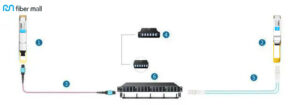
| Number | Product |
|---|---|
| ① | 400G DR4 QSFP-DD |
| ② | 100G-DR QSFP28 |
| ③ | 8-core MTP fiber patch cord |
| ④ | 8-core MTP fiber distribution patera |
| ⑤ | LC Duplex Fiber Patch Cord |
| ⑥ | FHD fiber optic distribution box |
- 400G-8x50G direct connection
Although 50G Ethernet is currently not very popular in the market, it will drive the 50G Ethernet development to a certain extent with the rapid development of 400G Ethernet, because it can provide an expansion path for the upcoming 400G Ethernet (400Gbps transmission through eight 50Gbps channels). The 400G-8x50G direct connection solution is similar to the above 400G-4*100G direct connection solution. Taking a 400G SR8 optical transceiver as an example, one end uses a 16-core MTP fiber jumper, and the other end uses an LC duplex fiber jumper to connect eight 50G optical transceivers, as shown below.
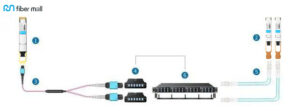
| Number | Product |
|---|---|
| ① | 400G DR8 QSFP-DD |
| ② | 50G-SR QSFP28 |
| ③ | 16-core MTP branch fiber patch cord |
| ④ | MTP fiber distribution patera |
| ⑤ | LC Duplex Fiber Patch Cord |
| ⑥ | FHD fiber optic distribution box |
Conclusion:
It is easy to find that the construction of the 400G network is inseparable from MTP cabling. With the maturity and popularization of 400G Ethernet, the MTP cabling solution will become the mainstream solution for high-performance and high-density network construction such as large-scale data centers in the future.
Table of Contents
ToggleRelated Products:
-
 QSFP-DD-400G-SR8 400G QSFP-DD SR8 PAM4 850nm 100m MTP/MPO OM3 FEC Optical Transceiver Module
$149.00
QSFP-DD-400G-SR8 400G QSFP-DD SR8 PAM4 850nm 100m MTP/MPO OM3 FEC Optical Transceiver Module
$149.00
-
 Cisco QDD-400G-DR4-S Compatible 400G QSFP-DD DR4 PAM4 1310nm 500m MTP/MPO SMF FEC Optical Transceiver Module
$400.00
Cisco QDD-400G-DR4-S Compatible 400G QSFP-DD DR4 PAM4 1310nm 500m MTP/MPO SMF FEC Optical Transceiver Module
$400.00
-
 Cisco QDD-400G-FR4-S Compatible 400G QSFP-DD FR4 PAM4 CWDM4 2km LC SMF FEC Optical Transceiver Module
$500.00
Cisco QDD-400G-FR4-S Compatible 400G QSFP-DD FR4 PAM4 CWDM4 2km LC SMF FEC Optical Transceiver Module
$500.00
-
 Cisco QDD-400G-LR8-S Compatible 400G QSFP-DD LR8 PAM4 LWDM8 10km LC SMF FEC Optical Transceiver Module
$2500.00
Cisco QDD-400G-LR8-S Compatible 400G QSFP-DD LR8 PAM4 LWDM8 10km LC SMF FEC Optical Transceiver Module
$2500.00

